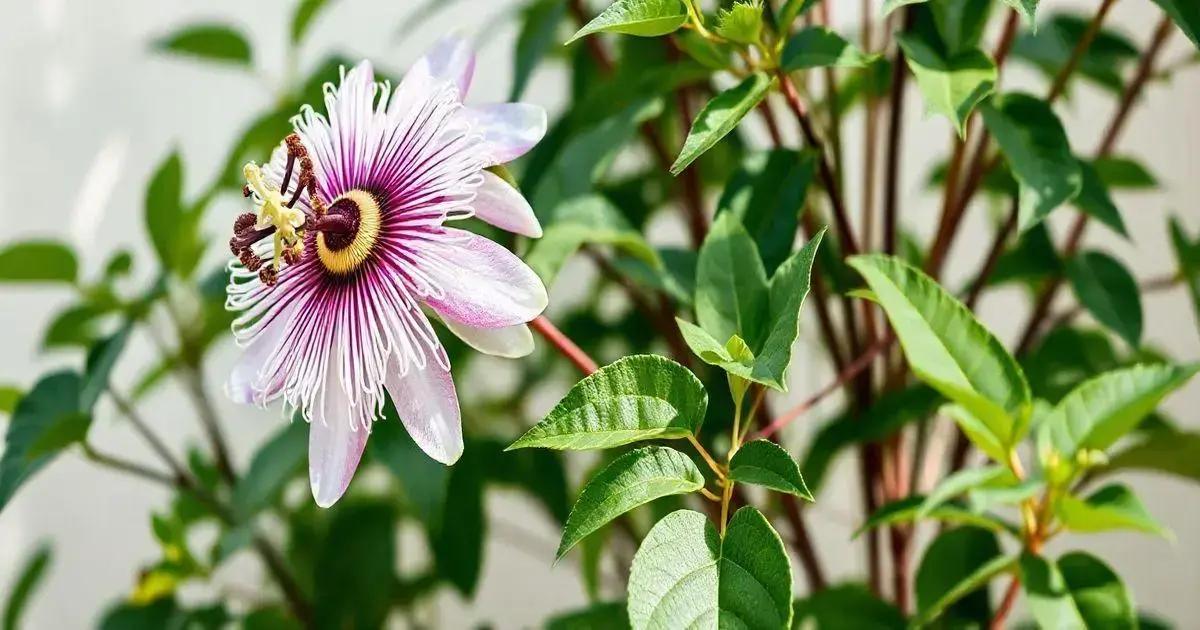How to Care for a Passion Flower Plant: 5 Essential Tips for Growth
How to care for a passion flower plant effectively requires understanding a few essential elements. Growing these stunning climbers can be incredibly rewarding when you know what they need for optimal growth. Join us as we explore the crucial aspects that will keep your passion flowers flourishing all season long.
Table of Contents
ToggleFive essential tips for thriving passion flowers
How to care for a passion flower plant begins with understanding the essential elements that promote thriving growth. Passion flowers are not just beautiful; they are resilient vines that can flourish in the right conditions. Here are five essential tips to help you cultivate these stunning plants successfully.
1. Provide optimal sunlight exposure
Passion flowers thrive in full sun, requiring at least 6 to 8 hours of direct sunlight each day. Inadequate light can lead to weak growth and fewer blooms. Consider these tips for sunlight management:
- Choose a location where the plant can soak up as much sun as possible.
- If you are growing in a partially shaded area, select a variety that can tolerate less light.
- Rotate container-grown plants periodically to ensure even sunlight exposure.
2. Understand soil requirements
Well-draining, fertile soil is crucial for healthy passion flower growth. The following steps can help optimize soil conditions:
- Use a mix of potting soil and compost to enrich nutrients.
- For outdoor planting, amend with organic matter to improve drainage.
- Test soil pH, aiming for a range of 6.0 to 7.0 for ideal growth.
3. Water consistently but wisely
Maintaining a proper watering schedule is vital. Here’s what you need to keep in mind:
- Water deeply at least once a week, allowing the top inch of soil to dry out between sessions.
- Adjust your watering frequency based on seasonal changes; passion flowers may require more water during hotter months.
- Beware of waterlogged soil, as this can lead to root rot.
4. Fertilize for success
Regular fertilizer application supports healthy growth and blooming. Consider these fertilization practices:
- Use a balanced fertilizer every 4-6 weeks during the growing season.
- Watch for signs of nutrient deficiencies, such as yellowing leaves or stunted growth.
- For container plants, switch to a slow-release fertilizer to ensure continuous nourishment.
5. Implement effective pest control
Keeping pests at bay is necessary for the health of your passion flowers. Follow these simple steps:
- Inspect your plants regularly for signs of common pests like aphids or spider mites.
- Use insecticidal soap or neem oil as natural pest control solutions.
- Encourage beneficial insects, like ladybugs, to help manage pest populations.
By following these five essential tips for thriving passion flowers, you’ll nurture a vibrant garden that showcases the stunning beauty of these unique blooms. For more insights, consider exploring indoor gardening techniques that can support your gardening skills.
Understanding sunlight needs for passion flower plants

Understanding sunlight needs for passion flower plants is crucial for successful cultivation. These vibrant vines thrive best when provided with the right amount of sunlight, which significantly influences their growth and flowering.
The importance of sunlight exposure
Sunlight affects not just the growth rate but also the overall health of passion flowers. Here’s why sunlight is essential:
- Enhances photosynthesis, which fuels plant growth.
- Encourages blooming, leading to more vibrant flowers.
- Helps prevent diseases by promoting airflow and reducing humidity around the plant.
Optimal sunlight conditions
To ensure your passion flowers receive adequate sunlight, consider the following recommendations:
- Grow passion flowers in areas where they can soak up full sun for at least 6 to 8 hours daily.
- Observe the sunlight pattern in your garden to find the sunniest spots, particularly during peak growing seasons.
- If growing indoors, place them near south-facing windows for maximum light exposure.
Signs of insufficient sunlight
Be attentive to your plants’ signals indicating they aren’t receiving enough light:
- Leggy growth: Stretched stems with fewer leaves.
- Pale leaves: Yellowing or discoloration often occurs in low light.
- Reduced blooming: Fewer flowers or smaller blooms than expected.
Adjusting sunlight for indoor plants
Indoor gardening can pose additional challenges regarding sunlight. Here are tips on maximizing light for passion flowers indoors:
- Consider using grow lights to supplement natural light, especially in winter.
- Rotate plants regularly to ensure all sides receive light.
- Use reflective materials like mylar or white walls to boost ambient light.
By understanding and meeting the sunlight needs for passion flower plants, you can foster healthy growth and an abundance of charming blooms. If you’re interested in enhancing your gardening skills further, consider exploring indoor gardening techniques that provide more tips and strategies.
Common pests and their control methods
Common pests and their control methods are critical in safeguarding your passion flower plants. Understanding which pests can harm them and how to effectively manage these pests ensures your plants thrive.
Identifying common pests
Many pests can wreak havoc on passion flowers. Below are some of the most common offenders:
- Aphids: Small, soft-bodied insects that suck the sap from plants.
- Spider mites: Tiny arachnids that create fine webs and cause leaf discoloration.
- Mealybugs: Woolly pests that feed on the plant’s sap and produce a sticky residue.
- Whiteflies: Small, white moth-like insects that sap energy from the plant.
Effective control methods
Taking action promptly can help manage pest populations. Here are several effective control strategies:
- Regular inspection: Routinely check the undersides of leaves and stems for signs of pests.
- Natural remedies: Use neem oil or insecticidal soap to treat infestations without harming beneficial insects.
- Hand removal: For small infestations, simply wipe away pests with a damp cloth or use a strong stream of water to dislodge them.
- Introduce beneficial insects: Ladybugs and lacewings can help control aphid populations naturally.
When to take action
Knowing when to intervene is key to effective pest management. Watch for:
- Rapidly declining health in your passion flowers.
- Visible pests or webbing on leaves.
- Leaves turning yellow or dropping prematurely.
By being proactive and understanding the common pests and their control methods, you can maintain the health and beauty of your passion flower plants. For additional guidance on pest management, consider exploring indoor gardening techniques that can enhance your overall gardening experience.
In conclusion
Caring for a passion flower plant requires attention to various factors, including sunlight, soil, watering, fertilization, and pest control. By implementing the tips provided throughout this guide, you can ensure that your passion flowers thrive, showcasing their vibrant blooms and lush foliage. Remember to monitor your plants regularly and adapt your care methods based on their needs. Additionally, for further insights and tips on enhancing your indoor garden, explore more resources to elevate your gardening experience.

